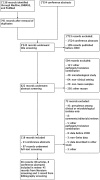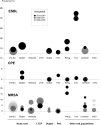Antibiotic-resistant pathogens in different patient settings and identification of surveillance gaps in Switzerland - a systematic review
- PMID: 31466538
- PMCID: PMC6805757
- DOI: 10.1017/S0950268819001523
Antibiotic-resistant pathogens in different patient settings and identification of surveillance gaps in Switzerland - a systematic review
Abstract
The prevalence of antimicrobial resistance (AMR) varies significantly among different patient populations. We aimed to summarise AMR prevalence data from screening studies in different patient settings in Switzerland and to identify surveillance gaps. We performed a systematic review, searching Pubmed, MEDLINE, Embase (01/2000-05/2017) and conference proceedings for Swiss studies reporting on carbapenemase-producing Enterobacteriaceae (CPE), extended-spectrum beta-lactamases (ESBL), mobilised colistin-resistance, methicillin-resistant Staphylococcus aureus (MRSA) and vancomycin-resistant Enterococci (VRE) within different patient settings. We identified 2345 references and included 46 studies. For acute care patients, most screening data come from admission screenings, whereas AMR prevalence among hospitalised patients is largely unknown. Universal admission screenings showed ESBL-prevalences of 5-8% and MRSA-prevalences of 2-5%. For targeted screening, ESBL-prevalence ranged from 14-21%; MRSA-prevalence from 1-4%. For refugees, high ESBL (9-24%) and MRSA (16-24%) carriage rates were reported; returning travellers were frequently (68-80%) colonised with ESBL. Screening data for other pathogens, long-term care facility (LTCF) residents and pediatric populations were scarce. This review confirms high ESBL- and MRSA-carriage rates for risk populations in Switzerland. Emerging pathogens (CPE and VRE) and certain populations (inpatients, LTCF residents and children) are understudied. We encourage epidemiologists and public health authorities to consider these findings in the planning of future surveillance studies.
Keywords: Antibiotic resistance; Gram-negative bacteria; Methicillin - S. aureus resistant to (MRSA); Public health; Surveillance.
Conflict of interest statement
None.
Figures


References
-
- WHO factsheet on antibiotic resistance. WHO September 2016. Available at http://www.Who.Int/mediacentre/factsheets/fs194/en/ (Accessed 7 August 2019).
-
- Antibiotic Resistance Threats in the United States, 2013. Centers for Disease Control and Prevention (CDC) April 2013. Available at https://www.cdc.gov/drugresistance/threat-report-2013/pdf/ar-threats-201... (Accessed 7 August 2019).
-
- Schweizerisches Zentrum für Antibiotikaresistenzen. Institut für Infektionskrankheiten Universität Bern, Switzerland. Available at http://www.anresis.ch/ (Accessed 7 August 2019).
-
- European Antimicrobial Resistance Surveillance Network (EARS-Net). Available at https://ecdc.europa.eu/en/about-us/partnerships-and-networks/disease-and... (Accessed 7 August 2019).
-
- Strausbaugh LJ et al. (1996) Antimicrobial resistance in long-term-care facilities. Infection Control and Hospital Epidemiology 17, 129–140. - PubMed
Publication types
MeSH terms
LinkOut - more resources
Full Text Sources
Medical
Research Materials
Miscellaneous

